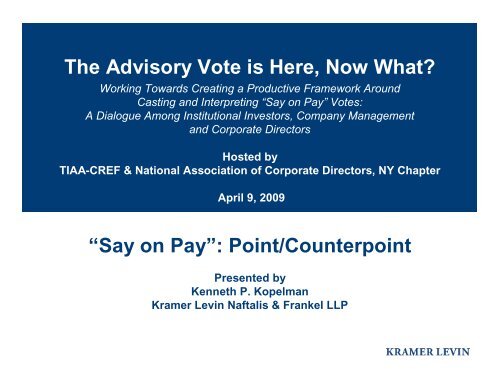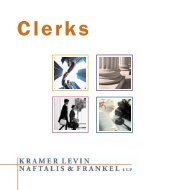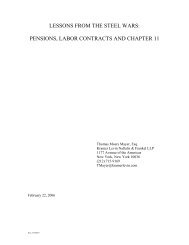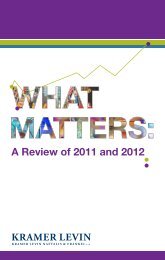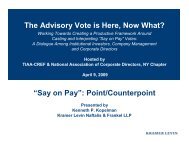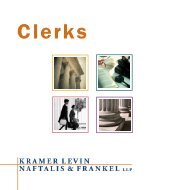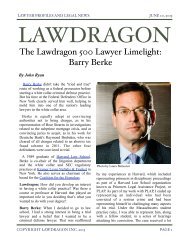POINT - Kramer Levin Naftalis & Frankel LLP
POINT - Kramer Levin Naftalis & Frankel LLP
POINT - Kramer Levin Naftalis & Frankel LLP
Create successful ePaper yourself
Turn your PDF publications into a flip-book with our unique Google optimized e-Paper software.
The Advisory Vote is Here, Now What?<br />
Working Towards Creating a Productive Framework Around<br />
Casting and Interpreting “Say on Pay” Votes:<br />
A Dialogue Among Institutional Investors, Company Management<br />
and Corporate Directors<br />
Hosted by<br />
TIAA-CREF & National Association of Corporate Directors, NY Chapter<br />
April 9, 2009<br />
“Say on Pay”: Point/Counterpoint<br />
Presented by<br />
Kenneth P. Kopelman<br />
<strong>Kramer</strong> <strong>Levin</strong> <strong>Naftalis</strong> & <strong>Frankel</strong> <strong>LLP</strong>
INTRODUCTORY NOTE:<br />
A version of these slides were part of my introductory presentation at<br />
the joint TIAA-CREF/NACD-NY “ Say on Pay” Program held in New York<br />
City on April 9, 2009. They are styled in a point/counterpoint format, setting<br />
forth many of the pro and con positions in the “Say on Pay” debate in the US<br />
over the past few years.<br />
As this was the first presentation at the Program, the hope was to<br />
establish some sort of baseline among the participants, so at a minimum,<br />
everyone was starting off with a shared base of knowledge regarding some of<br />
the more typical back and forth arguments. There’s very likely more than a bit<br />
of repetition and overlap, and perhaps some internal inconsistencies.<br />
Moreover, given the nature of the presentation, I’ve borrowed from third party<br />
op/ed pieces and reports. Weblinks to a number of the original materials from<br />
which arguments were drawn are listed in the back of this document.<br />
Ken Kopelman<br />
0709
<strong>POINT</strong>:<br />
1. Shareholders are the ultimate owners of the<br />
corporation and are entitled to a voice in executive<br />
compensation — more so today than ever before,<br />
given the current economic environment.<br />
1
<strong>POINT</strong>:<br />
1. Shareholders are the ultimate owners of the corporation and are entitled to a voice<br />
in executive compensation — more so today than ever before, given the current<br />
economic environment.<br />
COUNTER<strong>POINT</strong>:<br />
• Under our governance system, Shareholders elect<br />
Directors, and it is the job of those elected Directors —<br />
not the Shareholders — to oversee and monitor the<br />
corporation, including pay practices.<br />
2
<strong>POINT</strong>:<br />
2. Shareholders have always approved certain<br />
compensation items — such as new option plans and<br />
§162(m) plans. So this “Say on Pay” debate is not<br />
really a deep philosophical governance dilemma —<br />
it’s just a “line drawing” exercise. And it’s appropriate<br />
at this point in time to draw the line in a way that<br />
provides additional oversight and accountability.<br />
3
<strong>POINT</strong>:<br />
2. Shareholders have always approved certain compensation items — such as new<br />
option plans and §162(m) plans. So this “Say on Pay” debate is not really a deep<br />
philosophical governance dilemma — it’s just a “line drawing” exercise...<br />
COUNTER<strong>POINT</strong>:<br />
• Approval of compensation plans — whereby Boards<br />
are typically given broad discretion to make specific<br />
awards — is a fundamentally different function from<br />
the complicated and nuanced task of setting overall<br />
pay.<br />
4
<strong>POINT</strong>:<br />
2. Shareholders have always approved certain compensation items — such as new<br />
option plans and §162(m) plans. So this “Say on Pay” debate is not really a deep<br />
philosophical governance dilemma — it’s just a “line drawing” exercise...<br />
COUNTER<strong>POINT</strong> (continued) :<br />
• Shareholders are not privy to certain key data that<br />
informs many compensation determinations (e.g.,<br />
company-competitive issues and alternative<br />
opportunities available to individuals), so their “Say on<br />
Pay” votes may be based on incomplete information.<br />
• “Say on Pay” is a “slippery slope”: if there’s an<br />
advisory vote on pay — an area traditionally squarely<br />
within the Board’s sole purview — then<br />
5
<strong>POINT</strong>:<br />
2. Shareholders have always approved certain compensation items — such as new<br />
option plans and §162(m) plans. So this “Say on Pay” debate is not really a deep<br />
philosophical governance dilemma — it’s just a “line drawing” exercise...<br />
COUNTER<strong>POINT</strong> (continued) :<br />
• why not an advisory vote:<br />
• on strategy,<br />
• on R&D budgets,<br />
• on approach to energy use and conservation,<br />
• on one or more specific compensation — related<br />
issues (e.g., capping bonus opportunity as a<br />
percentage of salary),<br />
• on anything?<br />
6
<strong>POINT</strong>:<br />
2. Shareholders have always approved certain compensation items — such as new<br />
option plans and §162(m) plans. So this “Say on Pay” debate is not really a deep<br />
philosophical governance dilemma — it’s just a “line drawing” exercise...<br />
COUNTER<strong>POINT</strong> (continued) :<br />
• We should beware of turning business corporations<br />
into something they’re not: democracies run by voting<br />
shareholders.<br />
7
<strong>POINT</strong>:<br />
3. Shareholders aren’t seeking to themselves set<br />
executive pay — rather the goal is to heighten Director<br />
sensitivity and accountability by ensuring that pay<br />
decisions will be closely scrutinized.<br />
• Shareholders need a route they can take to<br />
express their views on Board-approved plans,<br />
many of which have turned out to contain skewed<br />
financial incentives, in certain cases promoting<br />
reckless risk-taking with Shareholder money.<br />
8
<strong>POINT</strong>:<br />
3. Shareholders aren’t seeking to themselves set executive pay — rather the goal is to heighten<br />
Director sensitivity and accountability by ensuring that pay decisions will be closely scrutinized.<br />
• Shareholders need a route they can take to express their views on Board-approved plans,<br />
many of which have turned out to contain skewed financial incentives, in certain cases<br />
promoting reckless risk taking with Shareholder money.<br />
COUNTER<strong>POINT</strong>:<br />
• There may have been excesses, but Shareholders<br />
already have a number of well-established routes to<br />
express their displeasure with pay practices:<br />
• via the Shareholder proposal process (which has<br />
led to an increasing number of advisory<br />
votes), and also<br />
• via votes against the reelection of selected or all<br />
Compensation Committee/Board members.<br />
9
<strong>POINT</strong>:<br />
3. Shareholders aren’t seeking to themselves set executive pay — rather the goal is to heighten<br />
Director sensitivity and accountability by ensuring that pay decisions will be closely scrutinized.<br />
• Shareholders need a route they can take to express their views on Board-approved plans,<br />
many of which have turned out to contain skewed financial incentives, in certain cases<br />
promoting reckless risk taking with Shareholder money.<br />
COUNTER-COUNTER <strong>POINT</strong>:<br />
• The Director removal process can be costly and<br />
unnecessarily divisive, perhaps out of proportion to the<br />
“Say on Pay” message that Shareholders want to deliver.<br />
10
11<br />
<strong>POINT</strong>:<br />
4. The UK (and some others) have “Say on Pay” and the<br />
sky hasn’t fallen.<br />
• The UK proxy advisory firms have been<br />
recommending no votes against somewhere<br />
between 10 and 15% of UK companies, the<br />
typical proposal garners 85-90% Shareholder<br />
approval, and the total number of outright<br />
rejections over the past 5 years is less than a<br />
few dozen, out of thousands of votes.<br />
• A high no vote is expected to result in<br />
engagement between the Compensation<br />
Committee and major shareholders,<br />
institutional investors, pension funds, etc. —<br />
hopefully, early on in the pay setting process<br />
for the following year.
<strong>POINT</strong>:<br />
4. The UK (and some others) have “Say on Pay” and the sky hasn’t fallen.<br />
COUNTER<strong>POINT</strong>:<br />
• At least five UK companies have received no votes on<br />
pay in 2009, including a no vote in the 90%’s at R.B.S.,<br />
so the UK’s historical model may itself be undergoing<br />
drastic change.<br />
• The UK governance regime, often lauded by activists,<br />
did not appear during the recent crisis to produce any<br />
better operating results/risk avoidance/value<br />
preservation than did the US system.<br />
12
<strong>POINT</strong>:<br />
4. The UK (and some others) have “Say on Pay” and the sky hasn’t fallen.<br />
COUNTER<strong>POINT</strong> (continued) :<br />
• The UK experience is not necessarily transferrable to<br />
the US, given a variety of important structural<br />
differences (e.g., concentration of votes, homogeneity<br />
of institutional holders).<br />
• If the principal motivation behind “Say on Pay” is to<br />
encourage Company/Shareholder interaction and<br />
discourse, it seems like an awfully blunt instrument.<br />
13
<strong>POINT</strong>:<br />
4. The UK (and some others) have “Say on Pay” and the sky hasn’t fallen.<br />
COUNTER<strong>POINT</strong> (continued) :<br />
• Widely-accepted Pay Guidelines of the type adopted by<br />
the UK pension organizations, combined with the UK’s<br />
“comply or explain” approach, may lead to standardized<br />
pay packages, stifling creativity.<br />
• If pay receives approval, Boards may be loathe to make<br />
any changes, fearing they would be “waking the baby” —<br />
even if changes in the company’s going forward business<br />
strategy would indicate changes in its going forward<br />
approach to pay and incentives.<br />
14
<strong>POINT</strong>:<br />
5. The time for half-measures has passed. The best way<br />
to get the Board’s attention is via mandated universal<br />
“Say on Pay” which will lead to greater transparency<br />
and accountability on pay decisions.<br />
15
<strong>POINT</strong>:<br />
5. The time for half-measures has passed. The best way to get the Board’s attention<br />
is via mandated universal “Say on Pay” which will lead to greater transparency<br />
and accountability on pay decisions.<br />
COUNTER<strong>POINT</strong>:<br />
• Boards and Compensation Committees have been<br />
making good progress over the last few years in<br />
eliminating, or at least reining in, abusive pay practices.<br />
The balance of power is clearly moving away from<br />
management, and squarely towards the independent<br />
Compensation Committee, with clear trends towards<br />
adopting best practices, including:<br />
• More frequent Executive sessions<br />
• 360° Performance Reviews of NEOs<br />
• Scrutinizing Peer Group selection<br />
16
<strong>POINT</strong>:<br />
5. The time for half-measures has passed. The best way to get the Board’s attention<br />
is via mandated universal “Say on Pay” which will lead to greater transparency<br />
and accountability on pay decisions.<br />
17<br />
COUNTER<strong>POINT</strong> (continued) :<br />
• Testing management performance hurdles vs.<br />
analysts’ outlooks<br />
• Hiring wholly independent advisors, whose only work for<br />
the company is to advise the Compensation Committee<br />
• Cracking down on severance pay packages and<br />
eliminating many, if not most, perqs<br />
• Some are even starting to look at bringing aboard new<br />
Directors with deep, real-world compensation expertise (a<br />
la audit committee standards of “financial literacy” and<br />
“financial expert”)
<strong>POINT</strong>:<br />
5. The time for half-measures has passed. The best way to get the Board’s attention<br />
is via mandated universal “Say on Pay” which will lead to greater transparency<br />
and accountability on pay decisions.<br />
COUNTER<strong>POINT</strong> (continued) :<br />
• Moreover, we’ve only had a few years with the SEC’s<br />
new, more detailed, compensation disclosure rules, so<br />
why not “muddle through” for a few more years under the<br />
current system?<br />
• Also, between TARP recipients and others, we will soon<br />
have some non-trivial, real life experience here in the US<br />
around “Say on Pay.” Why not wait and study that<br />
experience before expanding it mandatorily throughout<br />
corporate America?<br />
18
<strong>POINT</strong>:<br />
6. The Shareholders, as a group, are entitled to express<br />
their views via a vote on the topic of executive pay.<br />
19
<strong>POINT</strong>:<br />
6. The Shareholders, as a group, are entitled to express their views via a vote on<br />
the topic of executive pay.<br />
COUNTER<strong>POINT</strong>:<br />
• Which Shareholders are we talking about?<br />
• Concerns re: there being a smaller group of vocal<br />
Shareholders with narrow, parochial interests (not<br />
necessarily tied to pay issues), who may seek to<br />
embarrass the company and the Board by turning<br />
compensation determinations into a “public sport”.<br />
20
<strong>POINT</strong>:<br />
6. The Shareholders, as a group, are entitled to express their views via a vote on<br />
the topic of executive pay.<br />
COUNTER<strong>POINT</strong> (continued) :<br />
• Concerns re: the people making the actual voting<br />
determinations being (almost always) mere<br />
intermediaries, who do not necessarily<br />
beneficially own any portion of the shares they<br />
are voting; are these intermediaries making<br />
informed, long-term company-by-company<br />
decisions, or merely slavishly applying so-called<br />
“good governance” practices, and on a one-sizefits-all<br />
basis?<br />
21
<strong>POINT</strong>:<br />
6. The Shareholders, as a group, are entitled to express their views via a vote on<br />
the topic of executive pay.<br />
COUNTER<strong>POINT</strong>:<br />
• These concerns are amplified by the absence of<br />
any definitive study showing that adoption of such<br />
“good governance” practices lead to improved<br />
corporate performance and/or value.<br />
• Concerns re: there being Shareholders who,<br />
through derivative products, have bought the right<br />
to vote without having the economic risk attendant<br />
to their stock position.<br />
22
<strong>POINT</strong>:<br />
6. The Shareholders, as a group, are entitled to express their views via a vote on<br />
the topic of executive pay.<br />
COUNTER<strong>POINT</strong> (continued) :<br />
• The Compensation Committee is willing to engage in<br />
meaningful dialogue with interested and responsible<br />
long-term shareholders who own significant amounts of<br />
their company’s shares, but not to submit itself to a<br />
public flogging rife with emotion and hidden agendas.<br />
• Shareholders are entitled freely to vote their own<br />
individual self-interests; only the Board is best positioned,<br />
through the exercise of its fiduciary duties, to balance the<br />
longer-term interests of ALL Shareholders (and<br />
stakeholders).<br />
23
<strong>POINT</strong>:<br />
7. It’s only an advisory vote, it’s not binding, so what’s<br />
the big deal?<br />
24
<strong>POINT</strong>:<br />
7. It’s only an advisory vote, it’s not binding, so what’s the big deal?<br />
COUNTER<strong>POINT</strong>:<br />
• If it’s not a big deal, then why are so many spending so<br />
much time on it?<br />
• Boards will be forced to dedicate a significant slice of<br />
their limited time and attention to the issue, and at a<br />
time when many are struggling with true “corporate<br />
survival” issues.<br />
• There’s the media headline factor/the “what are you<br />
doing wrong” factor.<br />
25
<strong>POINT</strong>:<br />
7. It’s only an advisory vote, it’s not binding, so what’s the big deal?<br />
COUNTER<strong>POINT</strong> (continued) :<br />
• Most importantly, combined with the widespread<br />
adoption of Majority Voting, it is disingenuous to view<br />
“Say on Pay” votes as merely “advisory” — as the follow<br />
up vote — which will be binding — will likely be to<br />
unseat “non-compliant” Directors.<br />
• At the extreme, this “one-two punch” [no on pay, then<br />
voting against Directors] may be viewed as a back-door<br />
assault on the business judgment rule.<br />
26
<strong>POINT</strong>:<br />
8. “Say on Pay” will give the proxy advisory services -- who don’t<br />
have any fiduciary duties or skin in the game – even more power.<br />
• Shareholders don’t have the requisite sophistication or knowledge to<br />
decipher 25 to 75 pages of dense (and, some say, of questionable<br />
utility) compensation disclosure and cast thoughtful votes on complex<br />
pay packages.<br />
• A universal requirement for “Say on Pay” votes will not only require<br />
Institutional Shareholders to spend more time and $$ on analyzing<br />
compensation (at a significant cost to their participants), but — given<br />
their less than unlimited resources — will also lead them to farm out<br />
many voting decisions, and depend more than ever on proxy advisory<br />
firms.<br />
• The Proxy Advisory Firm business model may well lead to oversimplification<br />
of the issues (quantity over quality) and a check the box<br />
exercise. This is exacerbated by many such advisors’ use of a<br />
proprietary “black box” approach.<br />
• Concern that “Say on Pay” is likely to turn out to be “Pay as I Say”,<br />
even though pay is not susceptible to being set via a “cookbook” or<br />
“manual of scientific procedures” approach.<br />
27
<strong>POINT</strong>:<br />
8. “Say on Pay” will give the proxy advisory services -- who don’t have any fiduciary<br />
duties or skin in the game – even more power.<br />
COUNTER<strong>POINT</strong>:<br />
• Responsible Shareholders will look to the proxy firms for<br />
advice, but will not follow that advice slavishly; rather,<br />
many will vote according to their own internal policies, and<br />
will engage with companies prior to, and after, the vote.<br />
28
29<br />
<strong>POINT</strong>:<br />
9. Executive Compensation is too complicated a subject<br />
to be boiled down to a simple “up or down” vote. If a<br />
Company receives a high no vote, how can it know<br />
what message it should take away?<br />
• Was the problem with our disclosure?<br />
• With our selection of peer groups?<br />
• Was it the options/the bonus plan/the perqs?<br />
• Is pay just too darn high?<br />
• How will we know what the biggest problem<br />
areas were?<br />
• How will we know what we should be<br />
changing? How can we make the vote<br />
“actionable”?
<strong>POINT</strong>:<br />
9. Executive Compensation is too complicated a subject to be boiled<br />
down to a simple “up or down” vote. If a Company receives a high no<br />
vote, how can it know what message it should take away?<br />
COUNTER<strong>POINT</strong><br />
• Companies will know:<br />
• By reading the proxy advisors’ reports<br />
• By reading the press reports<br />
• Most importantly, by speaking to larger Shareholders<br />
who voted no, hopefully (in future years) in advance of<br />
pay program finalization<br />
30
<strong>POINT</strong>:<br />
9. Executive Compensation is too complicated a subject to be boiled<br />
down to a simple “up or down” vote. If a Company receives a high no<br />
vote, how can it know what message it should take away?<br />
COUNTER<strong>POINT</strong> (continued) :<br />
• Moreover, votes against the re-election of<br />
Compensation Committee members are just as “nonilluminating”<br />
in terms of specifics as are “Say on Pay”<br />
votes<br />
31
<strong>POINT</strong>:<br />
10.The “one size fits all” approach that seems on its way<br />
to universal adoption — RESOLVED, that the<br />
Shareholders approve the compensation of the<br />
executive group as disclosed in the Proxy — misses<br />
the mark.<br />
32
<strong>POINT</strong>:<br />
10. The “one size fits all” approach that seems on its way to universal adoption —<br />
RESOLVED, that the Shareholders approve the compensation of the executive<br />
group as disclosed in the Proxy — misses the mark.<br />
COUNTER<strong>POINT</strong>:<br />
• Notwithstanding that some sort of mandatory universal<br />
rule may be politically irresistible, there have been a<br />
number suggestions to move away from the “one size<br />
fits all” approach:<br />
• Schering Plough’s shareholder survey — mailed<br />
out with the 2009 proxy<br />
• Professor Gordon’s “opt in” via Shareholder vote<br />
approach, or having required votes apply only to<br />
the 500 largest companies<br />
33
<strong>POINT</strong>:<br />
10. The “one size fits all” approach that seems on its way to universal adoption —<br />
RESOLVED, that the Shareholders approve the compensation of the executive<br />
group as disclosed in the Proxy — misses the mark.<br />
COUNTER<strong>POINT</strong> (continued) :<br />
• (Contra: unless all public companies are required<br />
to conduct a vote, those who are not required may<br />
have a competitive advantage vis a vis executive<br />
compensation (structures and levels) over those<br />
who are)<br />
34
<strong>POINT</strong>:<br />
10. The “one size fits all” approach that seems on its way to universal adoption —<br />
RESOLVED, that the Shareholders approve the compensation of the executive<br />
group as disclosed in the Proxy — misses the mark.<br />
COUNTER<strong>POINT</strong> (continued) :<br />
• Permit companies who receive support above a<br />
certain threshold to skip a year (or two or three)<br />
before having to go back to Shareholders<br />
• Permit only those Shareholders who have held<br />
their shares “long” for some period (6 months?) to<br />
have a “Say on Pay” vote (to ameliorate concerns<br />
re: vote buying/renting)<br />
• Permit flexibility in fashioning the resolution: e.g.,<br />
Littlefield Corporation’s “are we within 20% of an<br />
acceptable number?” approach<br />
35
<strong>POINT</strong>:<br />
10. The “one size fits all” approach that seems on its way to universal adoption —<br />
RESOLVED, that the Shareholders approve the compensation of the executive<br />
group as disclosed in the Proxy — misses the mark.<br />
COUNTER<strong>POINT</strong> (continued) :<br />
• RiskMetrics tripartite approach, calling for separate<br />
annual votes on:<br />
• Compensation Philosophy<br />
• Awards made in prior year<br />
• Goal setting for current year<br />
36
<strong>POINT</strong>:<br />
11. “Say on Pay” is a measured, focused tool to<br />
help Institutional Investors towards achieving<br />
their long-term goals.<br />
37
<strong>POINT</strong>:<br />
11. “Say on Pay” is a measured, focused tool to help Institutional Investors towards<br />
achieving their long-term goals.<br />
COUNTER<strong>POINT</strong>:<br />
• Perhaps true under the current rules of play, where<br />
investors “pick and choose” their presumably most<br />
deserving targets, but beware the possibility that<br />
universal “Say on Pay” will end up being overkill,<br />
overwhelming the proxy system and diluting the impact<br />
of NO votes, even where NO votes are appropriate.<br />
38
<strong>POINT</strong>:<br />
11. “Say on Pay” is a measured, focused tool to help Institutional Investors towards<br />
achieving their long-term goals.<br />
COUNTER<strong>POINT</strong> (continued) :<br />
• Beware other possible impacts of the law of unintended<br />
consequences:<br />
• Note the results of prior government/regulatory<br />
initiatives in the pay area, e.g., golden parachutes<br />
and §162(m)<br />
• Some suggest that the wholesale adoption of<br />
option grants in the 1990’s (now generally<br />
discredited) resulted at least in part from<br />
Institutional Investors’ enthusiasm for options as a<br />
close to perfect “pay for performance” vehicle<br />
39
<strong>POINT</strong>:<br />
11. “Say on Pay” is a measured, focused tool to help Institutional Investors towards<br />
achieving their long-term goals.<br />
40<br />
COUNTER<strong>POINT</strong> (continued) :<br />
• Another possible unanticipated consequence: If a<br />
company’s Shareholders approve the “Say on Pay”<br />
resolution, will Directors of that company somehow<br />
be shielded from later charges of excess<br />
compensation/corporate waste?<br />
• Lastly, and perhaps most importantly: Companies<br />
and Shareholders alike — and the entire<br />
“governance industry” — will be committing<br />
significant resources to the “Say on Pay” process;<br />
consider, on a “cost/benefit” analysis, whether such<br />
commitment will ultimately really be worth it?


